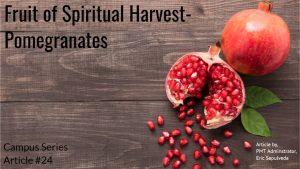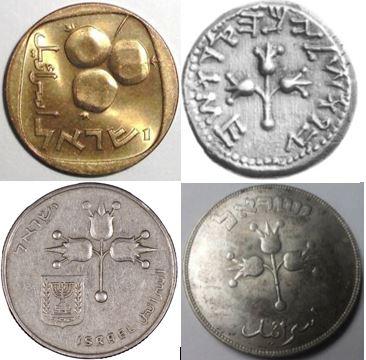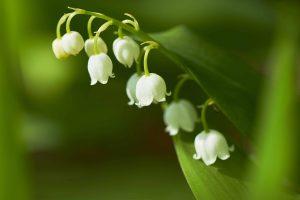Fruits of Spiritual Harvest-Pomegranates

While all of the Seven Species (wheat, barley, grape vines, figs, pomegranates, olives, & dates) were acceptable Tabernacle and Temple offerings, only pomegranates were actively incorporated into worship service. Pomegranate’s iconic blood-red juice and it’s hundreds of nutrient-rich fruits pointed ancient Israel to Christ who would not only heal sickness, but whose blood would cover their spiritual blemishes.
Pomegranates are highly popularized as a “super fruit” for its array of health benefits. Pomegranate’s deep red come from polyphenols which are powerful antioxidants, which can help remove cell damaging free radicals. Due to its anti-inflammation properties, preliminary studies suggest that it can alleviate symptoms associated with arthritis and pomegranate juice’s ability to improve blood flow may aid in lowering blood pressure in patients not taking medications like statins. Like the previously written about copper, silver, and gold metals seen throughout the Tabernacle, pomegranates have shown to be strongly antibacterial and antiviral possibly helping to prevent contraction of common infections and viruses.
Several cultures viewed pomegranates as symbols of fertility (ref. Ezekiel 19:10; Song of Solomon 6:11, 7:12, 8:2) and beauty due to their hundreds of jewel shaped fruits. Song of Solomon describes a beautiful woman’s blushing cheeks (or temples) behind her locks of hair (or veil) like two halves of a pomegranate (ref. Song of Solomon 4:3, 6:7). Pomegranates were signs of prosperity and their absence was considered a signal that Israel was being punished (ref. Number 20:5; Joel 1:12).
Though they can contain between 400-1,200 arils, due to their strong connection to Jewish religious practices, it had long been rumored that pomegranates contain 613 seeded fruits, corresponding to the 613 commandments of the Torah, thus motivating many ceremonial Torah scrolls to be decorated with pomegranates on their handles. The pomegranate’s six petal flower has also been suggested to have inspired Israel’s current national symbol: the Star of David. Ancient coins struck during the First Jewish Revolt against Rome before the Destruction of Jerusalem in 70 A.D. bear the image of a three fruited pomegranate branch, signifying that the Jewish independence fighters considered pomegranates national and religious symbols. Coins minted by the modern Israeli state continue to bear trios of pomegranates.

Aaron’s ministerial High Priest ephod garment was adorned with red, blue, and purple pomegranates around the hem of the robe. Alternating between these woven pomegranates were golden bells, whose sound would “be heard when [the High Priest] enters the Holy Place before the Lord and when [the High Priest] comes out, so that he will not die” (Exodus 28:35). This verse has unfortunately led to the incorrect belief, based on 13th century Jewish scholar Zohar’s conclusion, that the high priest wore a belt around their ankle or waist to be pulled out of the Tabernacle in the event that they died while ministering, just as Aaron’s sons Nadab and Abihu were burned up by Divine Fire when they offered “strange fire” (Leviticus 10:1-3). The silence of the golden bells, while the High Priest was in the Holy of Holies, was not something to even consider, since he only wore white linen garments while ministering on the Day of Atonement (Leviticus 16:4,23,24,32).
When Solomon built the first Temple of Jerusalem, he ensured the inclusion of pomegranates in the design. The entrance to the Temple contained two 27 foot tall copper pillars which were decorated with a series of latticework carved in the form of 100 pomegranates encircling the capitals which crowned the pillars (2 Kings 25: 17; 2 Chronicles 3: 15-17). The pillars also included carved lilies amongst the pomegranate encircled capitals, which when considering the hem of the high priest’s ephod, may have also been bell-shaped, possibly implying they were Lilies of the Valley.

Pomegranates are famous for their deep blood-red juice, which seems to penetrate and stain nearly everything it comes into contact with. This seemingly stands in strong contrast with the radiantly white bell-shaped Lilies of the Valley they are likely paired with on both the hem of the High Priest’s ephod and around the capitals of the two pillars at the entrance of Solomon’s Temple. If pomegranate’s crimson nectar is meant to represent Christ’s Blood covering our sins and making them white as snow (ref. Isaiah 1:18), that would explain why the Ephod, hemmed with the crafted yarn pomegranates and golden bells, was not worn when the High Priest entered the Holy of Holies on the Day of Atonement. Simply wearing lily white linen garments would have been the only way to have come before the Lord (ref. Ezekiel 44: 17-19; Revelation 19:8; Exodus 28:41-43).
Pomegranate’s maroon antioxidant-saturated nectar not only promotes radiant health, but represents the Blood of Christ that washes us as white as the Lilies of the Valley, offering us Eternal Life. Their hundreds of jewel like fruits are reminders that we are each capable and responsible for producing an overwhelming amount of spiritual fruits.
Prepared by, Kent Simpson, Apostolic Prophet & Eric Sepulveda, PMT Administrator
For more prophetic media groups click here



